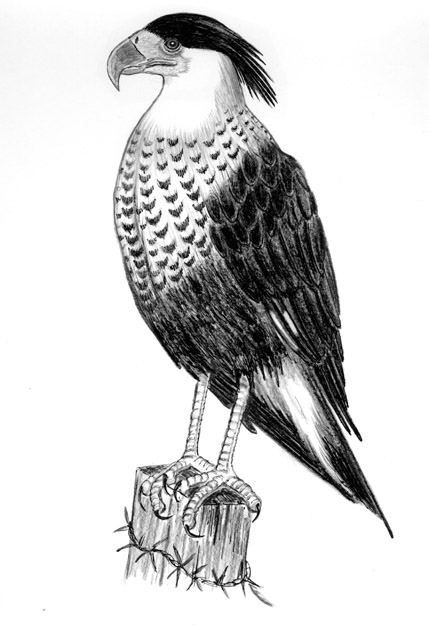
Dear Bird Folks,
I’ve recently moved to Austin, TX and I’m looking forward to seeing new some birds, especially a Crested Caracara. My Texas Peterson guide refers to them as the “Mexican Eagle,” yet I’m under the impression that caracaras are scavengers. Wouldn’t a better name for them be “Mexican Vultures”?
– Nathanial, Austin, TX
Not me, Nate,
I’m not about to contradict anything Roger Tory Peterson has written. In the world of birding his word is law. If RTP says caracaras are called “Mexican Eagles” that’s the end of the conversation. Heck, if he wants to call goldfinches “flying lemons” then that’s what they are going to be called. However, in this case I think Peterson is merely referring to this bird’s colloquial name and not stating that caracaras are truly eagles. It’s like calling Sylvester Stallone the “Italian Stallion.” Nobody really thinks Stallone is a horse. Most folks think he’s more of a horse’s…never mind.
Crested Caracaras are unusual birds and ornithologists don’t quite know what to do with them. Only about the size of a Red-tailed Hawk, they are way too small to be eagles. But, unlike most hawks, they love to eat dead, rotting things. So, as you said, Nate, that should make them vultures, right? Nope, not right. Ornithologists don’t think caracaras are vultures, hawks or eagles. For some reason, the folks in charge of such things think caracaras are falcons. Falcons? Are they kidding? It appears that the researchers have been spending too much time in the lab, breathing formaldehyde fumes. Maybe somebody should open a window for them.
The Crested Caracara is a medium-sized bird of prey that is most often found in grasslands, prairies and pastures. In the United States they breed in Texas and southern Arizona. There is also a small isolated population breeding in central Florida. The vast majority of these birds live in Mexico and in Central and South America. They are striking birds, with black bodies, white necks, red faces and blue beaks. They are strong fliers, but not particularly fast. (Way too slow to be a falcon.) They have ridiculously longs legs and are fast runners. (None of these traits sound very falcony to me.) The one thing they have in common with falcons is their love of meat. They’ll eat meat anyway they can get it, whether it’s fresh, rotting or cooked. Yes, cooked.
Many birds of prey are attracted to wild fires. They quickly pounce upon any creatures fleeing the flames. But chasing down fleeing creatures is way too much work for caracaras. They prefer to sit back and wait for the fire to pass. Then, after things have cooled down a bit, they fly down to investigate the burned area, searching for any well-done creatures that weren’t quick enough to escape the heat. To a caracara, brush fires are an invitation to a giant barbeque. (Ha! Now I understand why they like living in Texas so much.)
When they can’t find barbequed meat, they look for the next best thing…rotten meat. Every morning, long before all the other birds of prey have gotten out of bed, caracaras are out searching the roads for anything that didn’t look both ways before crossing the street the night before. Like retired men combing the beach with metal detectors, caracaras are up at the crack of dawn, flying low, seeking fresh road kill. If they find a squashed squirrel or rabbit, breakfast is served. But, if they come across something big and tough, like a dead cow, they have to wait. Not having the tools needed to break through thick hide, the birds must wait for some other creature – usually a vulture – to come along and do the dirty work for them. Once the cow has been opened up, the caracara moves in and rewards the vulture for its hard work by chasing it away.
Caracaras aren’t completely lazy, however. They’ll hunt if they are in the mood. Behaving like Cattle Egrets, they frequently follow tractors looking for insects or other creatures that are often stirred up by the machinery. While they are waiting for tractors to kick things up, they regularly do their own kicking. Knowing that delicious things can be found living under dried cow manure, the birds use their long legs to flip over cow patties in hopes of finding a yummy tidbit for lunch. This, of course, is another common Texas pastime.
Caracaras are often seen sitting on fence posts, dead trees or on the ground. You aren’t likely to see them soaring over head like typical birds of prey, because they are so not typical birds of prey. Even their name is whacky. Many folks think they are named after Irene Cara, the singer from the movie Flashdance. It turns out the name “caracara” comes from the Guarani, the native people of Paraguay. That last piece of information is supposedly true, but I’ve recently learned not to believe everything I read in the newspaper. You may want to check with some of your Guarani friends, just to be sure.
So there you have it. Caracaras aren’t eagles or vultures; for some reason they are falcons. Don’t ask me why. I’m sure it has to do with their skeletal structure, DNA or some other boring explanation. Whatever. Good luck in Texas, Nate. I hope you see lots of new birds. And remember, if you get hungry, look for a brush fire or flip over a few cow patties. You’ll be eating like a local in no time.